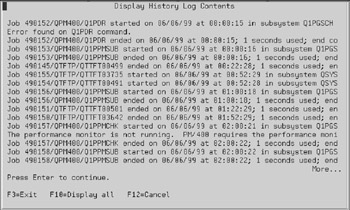The System Log, QHST
The i5 also provides a system-wide log called QHST. QHST records events in this log, which provides a history of system activity. (The system log gives very little information, because most of that information is recorded in job logs. Both the system log and the job logs are not adequate means to keep track of how much each user utilizes the system. If you are looking for that application, you should check Job Accounting.)
The Display Log (DSPLOG) command displays or prints the system log. You can provide some selection through parameters and, as with job logs, display complete information for the messages recorded in the log by positioning the cursor and pressing Help or F1. The system log panel is shown in Figure 3.9.

Figure 3.9: Example of the Display History Log Contents (DSPLOG) command.
The system log is a message queue object (*MSGQ); you can write to the system log directly with the Send Message (SNDMSG) command and supply TOMSGQ(QHST). For example:
SNDMSG MSG('Security violation at display station DSP13.') TOMSGQ(QHST) QHST has a fixed size. When it fills up, the system automatically creates a copy in a database file and then clears QHST of all contents. These old copies have names that begin with "QHST" plus a few digits. They are not message queues, but files. These files accumulate in your system's QSYS library, and it is your responsibility to delete them periodically.
Operational Assistant (see Chapter 7) can help you keep old system logs under control.
EAN: N/A
Pages: 245